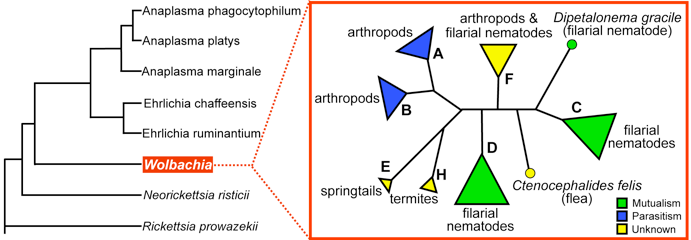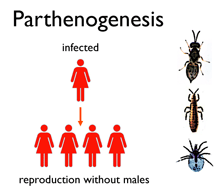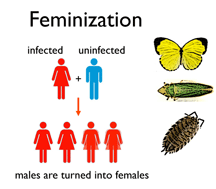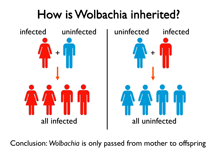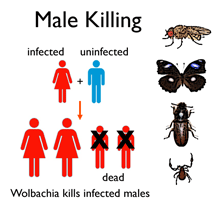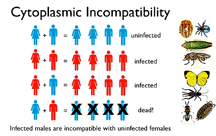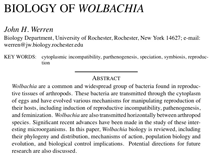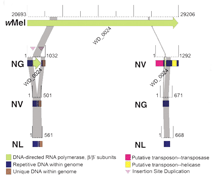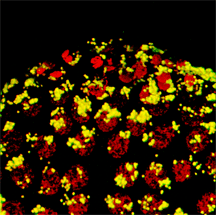Wolbachia Biology
Within arthropods Wolbachia has evolved four main modes of manipulating host reproductive biology in order to increase its own transmission. Critical to understanding Wolbachia biology and evolution is its mode of transmission. Wolbachia are not easily transmitted from one host to another. Instead, Wolbachia is almost exclusively transmitted from mother to offspring via infected eggs. Males can be infected with Wolbachia but males DO NOT transmit Wolbachia to offspring or any other hosts. The reproductive manipulation of hosts by Wolbachia include 1) feminization of infected males (turning genetic males into females). 2) Induced parthenogenesis (reproduction without males) 3) killing of infected males and 4) Cytoplasmic Incompatibility (CI), the modification of sperm from infected males resulting embryonic defects and death when sperm fertilize eggs not similarly infected.
Feminization
Feminization is perhaps the most obviously beneficial strategy for a maternally inherited bacterium such as Wolbachia. With males being dead-ends for the inheritance of most cytoplasmic factors (such as Wolbachia and mitochondria), conversion of infected genetic male offspring into females doubles the potential Wolbachia transmission to the following generation. To date however, Wolbachia-induced feminization is the most infrequently described of the four main Wolbachia-induced phenotypes, reported in only three Arthropod orders. Wolbachia-induced feminization has been documented most commonly in several species of terrestrial isopod within the order Oniscidae. Among insects, Wolbachia-induced feminization is only currently known to occur in Lepidoptera and Hemiptera.
Parthenogenesis
With males being an evolutionary dead end for Wolbachia inheritance, another obvious strategy of host manipulation by a maternally inherited endosymbiont is to induce parthenogenesis, the production of female offspring without fertilization by sperm. As with Wolbachia-induced feminization, parthenogenesis induction doubles the potential transmission of Wolbachia to the next generation, because all the progeny are female. Currently, Wolbachia-induced parthenogenesis is known from three different Arthropod orders; Thysanoptera (Thrips), Acari (mites) and Hymenoptera (wasps).
Male Killing
The third phenotype caused by Wolbachia is the killing of genetic males. Wolbachia should only evolve this phenotype when the killing of infected males benefits the surviving infected female siblings. Consequently, only hosts with high sibling competition for resources are those in which male-killing Wolbachia should persist. To date, male-killing Wolbachia infections have been described in four different Arthropod orders. Within insects, these include Diptera, Coleoptera and Lepidoptera. Outside of Insecta, male killing has been reported in pseudoscorpiones (class Arachnida).
Cytoplasmic Incompatibility (CI)
The most commonly described, and phylogenetically diverse Wolbachia-induced phenotype is CI, currently known from at least eight different arthropod orders: Acari, Coleoptera, Diptera, Isopoda, Lepidoptera, Hymenoptera, Homoptera and Orthoptera. CI is manifest when a Wolbachia-infected male mates with a female lacking the same Wolbachia type (either uninfected or infected with a different Wolbachia type). All other combinations of crosses are compatible. In diploid organisms, the result of an incompatible cross is increased embryonic mortality. At its most extreme, when a Wolbachia-infected male mates with an uninfected female, all offspring die (incompatible cross). The same infected male mated to a similarly infected female (compatible cross) sees no increase in offspring mortality. The spread of such Wolbachia through a population is easily explained theoretically. Briefly, in a mixed population (with both infected and uninfected individuals), the presence of Wolbachia-infected males increases the relative fitness of infected females by reducing the fitness of uninfected females.
Wolbachia and Lateral Gene Transfers
The lateral gene transfer from bacteria to multicellular eukaryotes was until recently thought to be rare or nonexistent. It is now becoming clear that such transfers from Wolbachia to the genomes of their hosts is widespread. The first such transfer was described in the adzuki bean beetle, where an ancient transfer of a large portion of a Wolbachia chromosome has been integrated into the beetle X chromosome. Analysis of whole genome sequences from several arthropod and nematode species has indicated that the transfer of genes from Wolbachia to host is widespread. The transfered genes range from small Wolbachia gene fragments found in the genomes of the parasitic wasp Nasonia, to a transfer of nearly the entire Wolbachia chromosome into the genome of the fruitfly Drosophila ananassae. Recently, another large-scale transfer of a Wolbachia genome into a host genome has been discovered in the Longicorn beetle. While the fate of such lateral gene transfers is largely unknown, examples are now emerging where transferred Wolbachia genes have acquired function within the host genome. Within aphids, genes from Wolbachia (or a close relative of Wolbachia) have been transferred into the host genome and are highly expressed in the insect bacteriocyte. In the mosquito, Aedes aegypti, two adjacent genes were likely transferred from Wolbachia to the mosquito genome and are expressed at relatively high levels, suggesting these genes have gained function within the mosquito genome. Another gene within a mosquito genome shows similarity to a Wolbachia gene, but was likely the result of a transfer from mosquito to Wolbachia.
Wolbachia in Filarial Nematodes
Filarial nematodes are small parasitic worms which can cause severe diseases in humans and other animals. Wolbachia has been described in a large proportion of filarial nematode species. Unlike the infections in most arthropods, Wolbachia within filarial nematodes seems to have evolved into mutualism - Wolbachia is essential for filarial nematode worm survival and reproduction. Recently it has become apparent that Wolbachia can significantly contribute to the pathogenicity of filarial nematode infection . Due to its essential involvement in filarial nematode biology, Wolbachia are now obvious targets for treatments controlling filarial nematode infections. For a review of Wolbachia - filarial nematode interactions see Taylor et al. 2005. For more information on using anti-Wolbachia agents to treat filarial nematode infections, see the Anti-Wolbachia Consortium.
